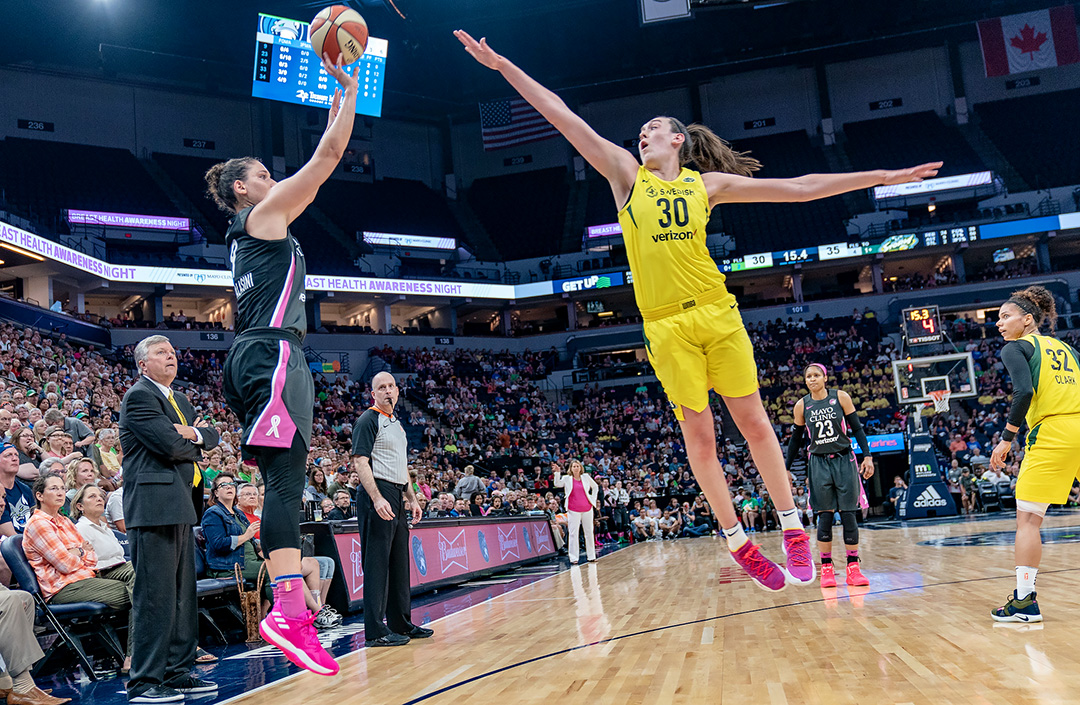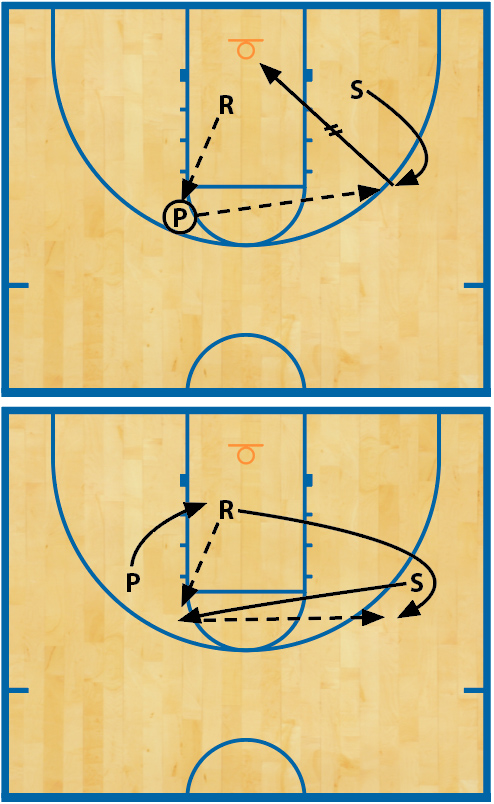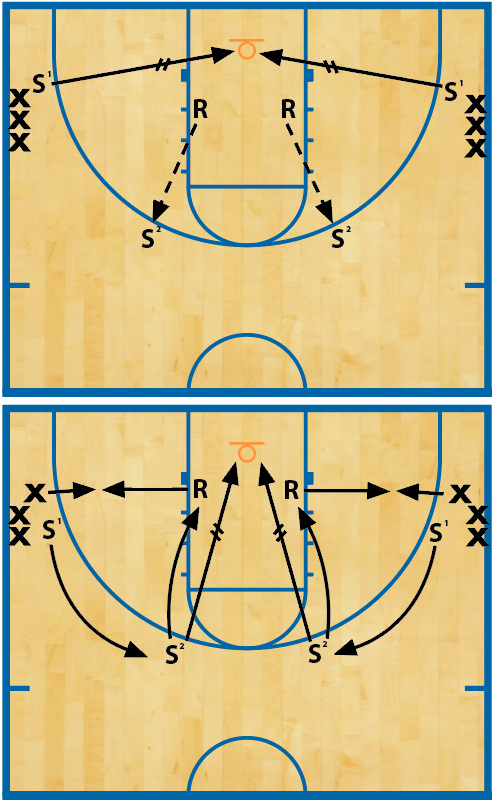Grinnell’s 7 drills to improve 3-point shooting

When deploying the 3-point shot as a specific offensive tactic, a team realizes significant statistical gains that can lead to success on the scoreboard.
Making a 3-point field goal provides 50% more points than hitting a 2-pointer. Also, the extra point provides some leeway in shooting percentage because if a team hits 33% of its 3-pointers, that’s comparable to nailing 50% on 2-point field goals.
If a coach decides to utilize the benefits of shooting more 3-pointers, the ultimate goal is to keep the shooting percentage from behind the arc at an acceptable rate for the level of competition. At Grinnell College, for example, we employ the 3-point shot as a specific offensive strategy. We have a goal of making 30% of our treys — which equates to 45% field goal shooting.In other words, shooting better than 30% gives us a built-in advantage over our opponents.
So, how do we achieve shooting 30% or higher from 3-point territory? We drill our players in the practice setting. Most coaches understand that performance on game night is directly correlated to what happens in practice. If a team chooses to employ a scheme to use the 3-pointer, it must make a commitment to practicing it.
Paired shooting

The single easiest way to practice 3-pointers is to shoot in pairs for a designated period of time every day during practice. Simply put, if a coach would commit to this drill for 15 minutes a day, they would see the team’s 3-point percentages rise.
DIAGRAM 1: Paired shooting. Choose areas of the floor where your players prefer to shoot 3-pointers in a game. Set up one player under the basket to rebound, and the other player at the chosen spot on the floor.
The shooter takes 10 shots in a row from that stationary position. Shooters should concentrate on balancing with the feet, shot mechanics and positive repetition. The rebounder provides the ball to the shooter with a “feathered” pass aimed toward the shooter’s chin.
» ALSO SEE: 55-minute shooting workout reinforces fundamentals
After 10 shots, the shooter and rebounder swap positions. If done with intensity, this paired shooting drill can provide 60 shots for each player in 15 minutes.
The Grinnell College men’s team, which is renowned for its 3-point shooting, can get 100 shots per player in a 17-minute paired shooting period.
Paired move-and-shoot

As with paired shooting, the coach chooses the area on the floor from which shooters take the shots.
DIAGRAM 2: Paired move-and-shoot. In this drill, the shooter moves into the shot from a typical offensive cut, while concentrating on getting a position facing the basket, catching and shooting with proper balance, and shot mechanics. The rebounder does the same job — rebound, allow for the cut, and pass toward the shooter’s chin. Each player should attempt 10 shots before rotating to the other position.
There’s a nice progression for the shooters if the coach asks for them to drill in pairs from a stationary position for a period time, and then the shooters move-and-shoot to end the drilling period. For example, a player shoots from a stationary position for 10 minutes, then performs move-and-shoot repetitions from the same spot on the floor for five minutes.

Three-player shooting
Similar to the paired move-and-shoot drill, three-player shooting provides a chance to shoot a lot of 3-pointers within the context of an offense.
In this drill, there is a shooter, rebounder and passer. The shooter makes a regular offensive cut, the passer gets the ball to the shooter (at the typical angle of the pass within the context of the offense), and the rebounder secures the ball and sends it to the passer.
DIAGRAM 3: Three-player shooting (A). This drill provides constant movement and the shooter takes only one shot at a time.
DIAGRAM 4: Three-player shooting (B). The rotation follows a pattern where the rebounder (R) becomes the shooter, the shooter (S) becomes the passer and the passer (P) becomes the rebounder.
Four-minute drill
Most coaches prefer some type of team shooting drill that can provide a chance to practice shooting with a little competition. We have two favorites.
The four-minute drill allows your team to work together to accomplish a goal.

DIAGRAM 5: Four-minute drill (A). In this drill, the entire squad is competing against the clock, and the players attempt to hit 100 3-pointers in four minutes.
DIAGRAM 6: Four-minute drill (B). Use both ends of the court and position your players on two sides of the basket at two shooting spots. Again, it’s important to have your players shoot from areas that are constant in your offense. Each side of the basket will have a ball (so there are two balls at the basket, and four balls total when you consider the other end of the court).
A shot is taken with a rebounder under the basket ready to get the ball and pass it to the other shooting line. The players rotate from the shooting position into the rebounding position.
Trying to make 100 threes in four minutes works for our team, but it might not work for every team. The coach should set the goal according to the level of their players.
Spot-shooting drill
Our second team shooting drill utilizes spot shooting. Choose four teams of players, and put two teams to a basket. Pick your shooting spots according to your offense, and line up your team at the spot. Position one player underneath the basket to be a rebounder. The drill starts with an inside-out pass from the rebounder to the shooter. Each team is trying to make 25 shots before the other team.
In this drill, the shooter gets to keep shooting if the first shot goes in. If it’s a miss, the shooter becomes the rebounder while the rebounder goes to the shooting line. A shooter can make three in a row and, if that occurs, bonus points are given on the third make.
Conditioning drill
Every day we run the floor with five players against no defense. This allows our players to shoot after they sprint into position.

A coach can use this type of drill in many ways: Drill the offensive plays, stretch out the players’ legs. We like to condition the team while still putting up shots.
We run a 30-point drill, usually at the end of practice, to condition players and emphasize 3-point shots while tired. In this drill, a group of five players advances down the floor in transition, moves into the designated offensive scheme, and attempts a 3-pointer.
On a made 3-pointer, the inbounder passes the ball from out of bounds. On a miss, the rebound is secured and passed to the point guard. The team then heads downcourt in the opposite direction, moves into the set offense and attempts a 3-pointer.
Each group makes three trips down and back for six total offensive possessions. A new group of five then steps on to the floor to make its three trips. Ideally, a team would have 15 players to provide proper rest.
Each time a basket is made, it’s added to the score. The entire team tries to make 30 points as quickly as possible. We also allow 2-point baskets within the context of the offense.
With our team, we can usually make 30 points in less than four minutes. The players are all winded when the drill is completed.
Interval track workout
Another way coaches can use the conditioning drill is to run the players like they’re doing an interval track workout.
Have the team make trips up and down the floor for a set period of time. Give them a time to rest (we do crunches during the rest period) and then have the team do another interval. Typically, three trips down-and-back — six offensive possessions — takes our team 60 seconds.
When our daily practice schedules are set up, we rarely do more than one individual shooting drill and one team drill. If a coach wants to commit to using the 3-point shot, taking 10 to 15 minutes a day in practice may provide the necessary repetitions to raise your team’s 3-point shooting percentages.
With the trey, every 3 percentage points is similar to improving 5 percentage points for 2-point shooting.
Using the 3-point shot can give your program an advantage against taller teams. It certainly has with our team, which is a squad filled with undersized players who can shoot the ball.
Andy Hamilton is the director of athletics and recreation at Grinnell College in Iowa. He also has coached men’s and women’s basketball at the school.









